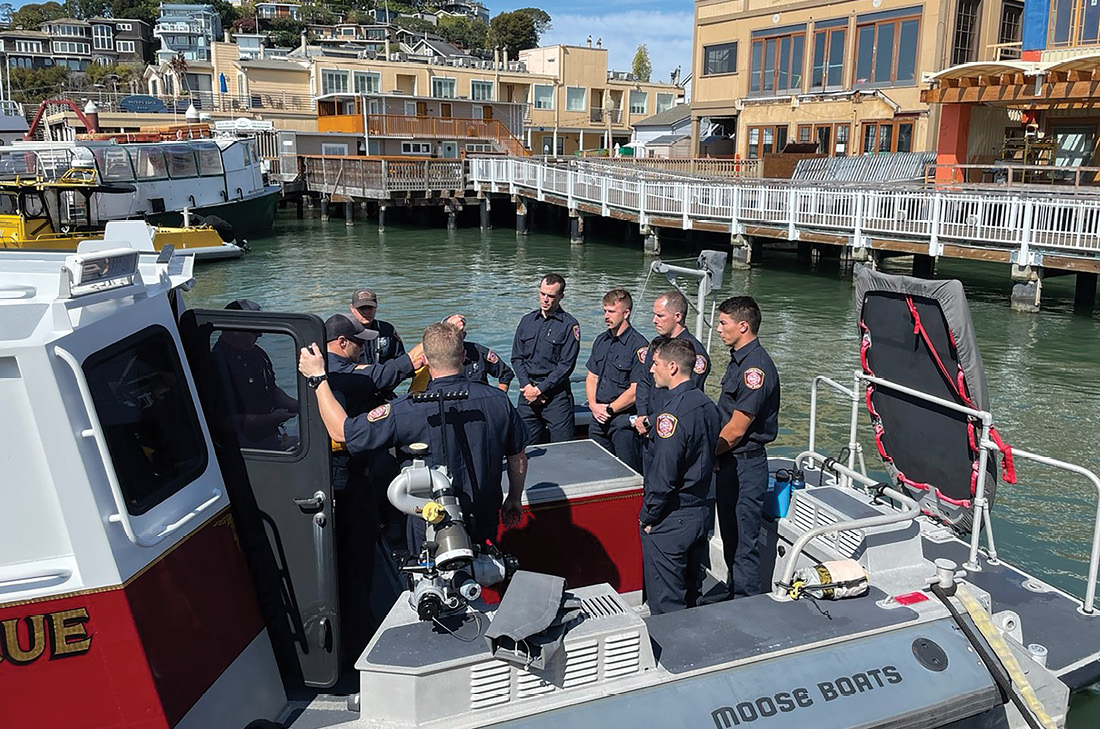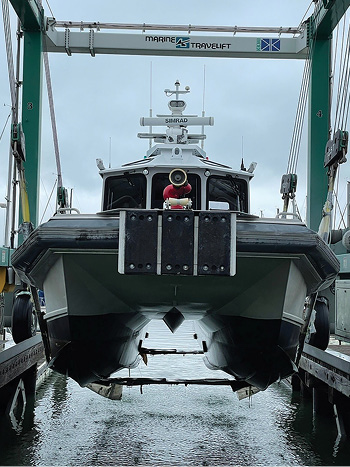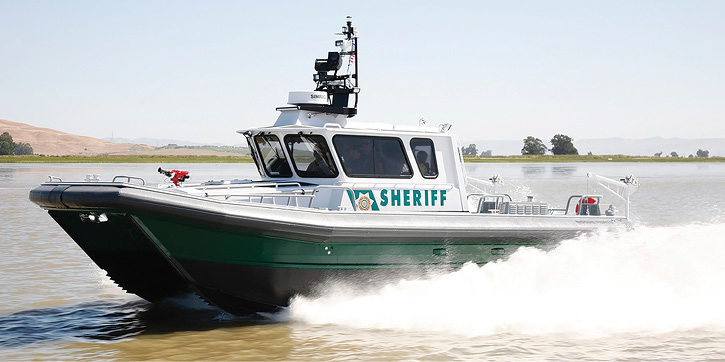
By Ken Royal
Coastal zones, rapidly moving rivers, and vast lakes all pose a serious need for a reliable, rugged fireboat. Departments stationed near waterways must realize the necessity of a proper vessel to meet the demands of protecting a waterfront.
It is important to consider what features a fireboat should have to battle the harsh conditions of water-based firefighting and water rescues.
Before taking the advice of others like, “Just go out and buy a boat with a pump on it,” “I can handle a boat … my family owns a bass boat,” or “I’ve got this … let me take the wheel,” learn how to go about finding the most appropriate rescue vessel by considering the following factors.
THE PLANNING STAGE
While it is great to have enthusiasm from personnel who wish to be involved in the planning stages of purchasing a fireboat, there are numerous hurdles that present themselves to even the most seasoned professionals. One of the first steps needed to ensure a successful boat purchasing mission is to assemble the individuals on the planning committee who will add value.
Departments that come with a well-organized assessment of what their operational needs are during the preconstruction meeting stand the greatest chance for a successful outcome. Identifying the department’s highest frequency calls, then building the vessel around those needs will help prevent unnecessary change orders and headaches that could reduce the quality of the end product while driving up costs at the same time.
CONFIGURATION OPTIONS
There are numerous systems, both mechanical and electronic, that go into these builds. Because we are discussing marine vessels, it is important to remember that buoyancy factors need to be accounted for when adding equipment and considering storage locations on the boat. Here are some considerations.
What are the basic characteristics of the best boat for your needs?
- What kind of propulsion is best for your needs? Jets? Outboards? Shaft and wheel? They all have their pluses and minuses.
- Gasoline or diesel? Diesel is safer, especially around fire.
- Overall length: If you are patrolling on a river, don’t buy a boat that is too long to turn around.
- Beam (width): Make sure your boat will fit into its intended slip.
- Enclosed cabin or T-top? In very cold or very hot weather, a fully enclosed cabin with HVAC will keep your crew safe and comfortable.
- Will you be doing aerial/helicopter operations? Make sure you have plenty of deck space for a stokes basket to land.
What kind of equipment do you need on the boat?
- Rescue equipment: rescue boards, Davits, Jason’s Cradle, ladders, etc.
- Fire suppression needs: Pumps, monitors, handlines, discharges, dewatering, foam, etc.
- Electronics: Chart plotters, radar, radios, depth sounders, down scan SONAR, side scan SONAR, FLIR, radio direction finders, CBRNE equipment and sensors, etc.
- Lighting: On deck spot, flood, or search; underwater dive lighting.
- Dive equipment: SCUBA tanks, BC, weight belts, dry and wet suits, masks, fins, etc.
- Firefighting equipment: SCBA, TICs, hand tools, fire attack hose, supply hose, dewatering suction hose, etc.
- Medical equipment: backboard, stokes, BLS, ALS, CPR devices, suction, monitor, etc.

1 When planning an emergency water vessel for your department, training has to be among the top considerations. (Photos by author.)

2 Ensure the fireboat you build will fit into its intended slip.

3 In very cold or very hot weather, a fully enclosed cabin with HVAC will keep your crew safe and comfortable.

4 Consider what type of propulsion fits your department’s needs. They all have pros and cons.
AREAS OF RESPONSE
Narrow waterways usually require a smaller boat. Bay and open waters often mean the possibility of large sea conditions and usually demand a bigger boat. Do your waters freeze in the winter? It might be worth increasing the thickness of your hull plating. How deep is your water? If it is shallow, get a shallow draft boat. You don’t want to become the rescuer who needs rescuing. Is the shore made up of soft sand or rip-rap? If the latter, maybe a double plate on the bow will help keep you afloat.
While the list above is far from complete, it should serve as an example of how important it is to ask yourself what the operational needs of the vessel are and your response area conditions. If you find that you are an “all risk” agency that needs to be prepared for all potential emergencies, then be prepared to lean on your best grant writer.
MAINTENANCE
Remember, buying a bigger boat isn’t always the best answer. Larger boats are in line with the age-old abbreviation: B.O.A.T.—Bust Out Another Thousand—and you can add an “s” to the end of thousand. The bigger the boat, the higher the costs when it comes to maintenance and repairs.
Another consideration when deciding on your boat’s systems is where and who will do the maintenance work. Some departments have in-house fleet managers who can handle simple oil and filter changes. However, if these managers typically work on rolling stock (i.e., fire apparatus and ancillary vehicles), they may not be aware of the necessary work involving anode replacements, antifouling needs, corrosion assessments, and evaluations. Having a marine-oriented mechanic is of utmost importance when maximizing the useful life of your vessel. Understanding galvanic corrosion and how to test for proper protection from stray electrical currents within your vessel’s harbor is a must. These factors will directly impact your vessel staying in service and in a ready state vs. out of service and needing expensive repairs. Budgetary considerations often have not been given proper attention when considering the true costs of maintaining a ready-state emergency vessel.
TRAINING
When you are in the midst of brainstorming on what would make the perfect emergency vessel for your department, training has to be among the top considerations. Is this vessel easy to learn how to pilot? How will you qualify your operators, deck crew, and officers in charge of marine emergencies? Who will issue the sign-offs and task books, and are they qualified to do so? Are there needs for continual testing, and who sets the pass/fail criteria? Will you have to cross staff the boat with an engine or truck company? Depending on experience, will you have “go/no-go” criteria in place that are emergency call dependent? These are valid questions that need answers to ensure the safety and effectiveness of your marine response plan.
Understand and thoroughly examine various options such as jet outdrives vs. traditional propeller propulsion systems. These systems come with trade-offs, however. If you expect to be on victim-in-the-water emergency calls, consider the safety benefits of jet outdrives over propellers. With no spinning blades under the surface, the rescue boat operator cannot mistakenly do harm should there be a brief wind shift or other force that takes the vessel off course.
GRANTS AND FUNDING
If you must secure funding outside your department, as many agencies do, there are specific tactics your department should employ to help better position itself to receive grant money. A high percentage of grants are consistently awarded to a small percentage of agencies that know how to best write them. If you can align yourself with neighboring agencies and show a collective benefit by adding a vessel to your agency, then the probability for success will increase markedly. If, for example, you are targeting Port Security Grant Program funding, having the support of the Captain of the Port/United States Coast Guard sector commander in addition to local search and rescue committee members will help secure these funds. Pay particular attention to the “investment justification” (IJ) section of the grant application. The IJs are where you will make your department’s needs known by stating how this vessel will enhance your public safety capabilities to better serve your community.
MANUFACTURER
Even if your department has a marine program already in place, or the department is just starting one, aligning yourself with a boat manufacturer that has years of experience specific to building emergency vessels is critical. Look for vessels that are currently in service and contact the agencies they belong to for references. Be sure to find the builder who always picks up your calls and projects a sense of commitment and responsibility to you and your team. This relationship is not just for the commissioning of your fireboat but should be one that is relied on throughout the useful life of the vessel.
These factors, including the planning stage, equipment, maintenance, training, grants, and manufacturers, are essential to finding, purchasing, and sustaining your marine response vessel. Evaluating the conditions of your waterways and identifying the criteria of a rescue boat needed to respond in these specific conditions are essential. With these considerations, a fire department can create a personalized craft suited to the needs of its geographic and climatic conditions.
KEN ROYAL is vice president of sales with Moose Boats, LLC. Before joining Moose, Ken served more than 20 years firefighting for the Tiburon (CA) Fire Protection District, both on land and in the marine environment.

